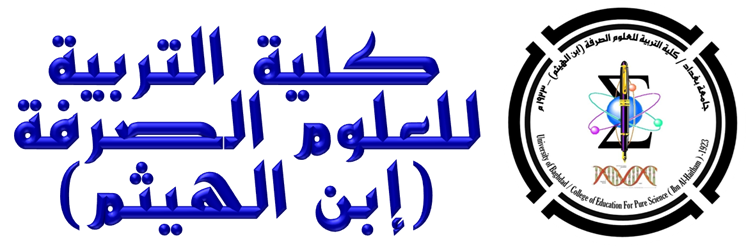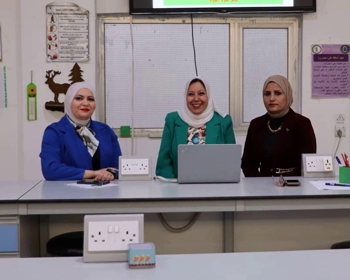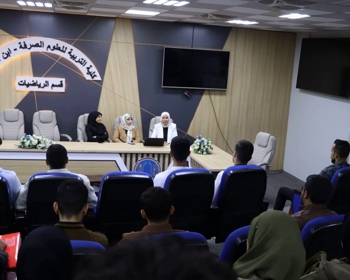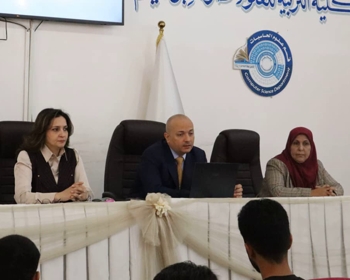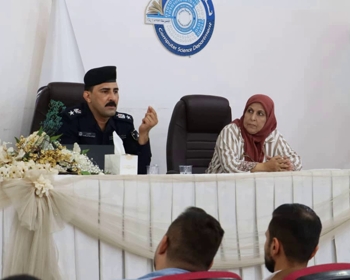ناقش قسم الكيمياء في كلية التربية للعلوم الصرفة – ابن الهيثم أطروحة الدكتوراه الموسومة ” أساليب التعلم وفق نموذج VARK والدافعية المعرفية وعلاقتها بالتفكير المنتج عند الطالب-المدرس في كلية التربية للعلوم الصرفة/ قسم الكيمياء ” للطالبة ” فرح هاني خليل ” التي انجزتها باشراف تدريسيا القسم ” أ.م.د. سهاد عبد الأمير عبود و أ.د. احسان عليوي ناصر ” ونوقشت من قبل أعضاء لجنة المناقشة المبينة أسمائهم في ما يأتي :
أ.د. ضمياء سالم داود – رئيسا
أ.د. ليث محمد عياش – عضوا
أ.د.علي محمود نجم – عضوا
أ.د. منذر مبدر عبد الكريم – عضوا
أ.م.د. جيهان فارس يوسف – عضوا
أ.د. احسان عليوي ناصر – عضوا و مشرفا
أ.م.د. سهاد عبد الأمير عبود – عضوا و مشرفا
ويهدف هذا البحث الى التعرف على:
1- أساليب التعلم وفقاً لأنموذج VARK لدى الطالب-المدرس في كلية التربية للعلوم الصرفة –ابن الهيثم/ قسم الكيمياء.
2- دلالة الفروق الاحصائية في أساليب التعلم وفقاً لأنموذج VARKلدى الطالب-المدرس في كلية التربية للعلوم الصرفة –ابن الهيثم/قسم الكيمياء وفقا لمتغير الجنس.
3- الدافعية المعرفية لدى الطالب-المدرس في كلية التربية للعلوم الصرفة –ابن الهيثم/ قسم الكيمياء.
4- دلالة الفروق الاحصائية في الدافعية المعرفية لدى الطالب-المدرس في كلية التربية للعلوم الصرفة –ابن الهيثم/قسم الكيمياء وفقا لمتغير الجنس.
5- التفكير المنتج لدى الطالب-المدرس في كلية التربية للعلوم الصرفة –ابن الهيثم/ قسم الكيمياء.
6- دلالة الفروق الاحصائية في التفكير المنتج لدى الطالب-المدرس في كلية التربية للعلوم الصرفة –ابن الهيثم /قسم الكيمياء وفقا لمتغير الجنس.
7- قوة واتجاه العلاقة بين أساليب التعلم وفقاً لأنموذج VARK والتفكير المنتج وتبعاً لمتغير الجنس.
8- قوة واتجاه العلاقة بين الدافعية المعرفية والتفكير المنتج وتبعاً لمتغير الجنس.
9- قوة واتجاه العلاقة بين اساليب التعلم وفقاً لأنموذج VARK والدافعية المعرفية وتبعاً لمتغير الجنس.
10- العلاقة الارتباطية بين متغيرات البحث مجتمعة (اساليب التعلم وفقاً لأنموذج VARK والدافعية المعرفية والتفكير المنتج) ومدى اسهام المتغيرات المستقلة (اساليب التعلم وفق أنموذج VARK والدافعية المعرفية) للتنبؤ بالمتغير التابع (التفكير المنتج).
وقد اعتمدت الباحثة على المنهج الوصفي الارتباطي، وتألفت عينة البحث من (200) طالب وطالبة من الطلبة- المدرسين في كلية التربية للعلوم –الصرفة ابن الهيثم / جامعة بغداد قسم الكيمياء) المرحلة الرابعة (من العام الدراسي 2021-2022 الدراسة الصباحية والمسائية والبالغ عددهم(318)طالب وطالبة، اذ تم اختيارهم بطريقة عشوائية بسيطة، وأُعدت الباحثة ثلاث أدوات للبحث اذ تمثلت بمقياس أساليب التعلم وفق نموذج فارك (VARK) المتكون من(30) فقرة ومقياس والدافعية المعرفية المتكون من(40 (فقرة واختبار التفكير المنتج المتكون من(21) فقرة، وقد تم التحقق من الخصائص السيكومترية متمثلة بالقوة التمييزية والصدق والثبات.
كما استخدمت الباحثة الوسائل الإحصائية لتحليل البيانات باستخدام الحقيبة الإحصائية للعلوم الاجتماعية SPSS وأظهرت النتائج الإحصائية:
1- ان الأسلوب البصري هو الأسلوب المفضل لدى الطلبة ثم يأتي الأسلوب الحركي وبعده السمعي، اما اقل أسلوب لدى افراد عينة البحث الحالي كان أسلوب القراءة والكتابة.
2- لا توجد فروقا ذات دلالة معنوية بين الذكور والاناث في جميع أساليب التعلم وفق نموذج VARK.
3- ارتفاع الدافعية المعرفية لدى عينة البحث الحالي.
4- هناك فروق ذات دلالة معنوية بين متوسطي درجات كل من الذكور والإناث وذلك لصالح الاناث في الدافعية المعرفية.
5- انخفاض التفكير المنتج لدى عينة البحث الحالي.
6- لا توجد فروق ذات دلالة معنوية بين الذكور والإناث في اختبار التفكير المنتج.
7-يوجد اسهام لأسلوب (التعلم البصري، اللغوي) في التفكير المنتج، في حين لا يوجد اسهام لأسلوب التعلم (السمعي، الحركي) في التفكير المنتج.
8-يوجد اسهام (الدافعية المعرفية) في التفكير المنتج.
في ضوء النتائج التي تم التوصل اليها في هذه الدراسة فيما يخص أساليب التعلم وفق أنموذج فارك والدافعية المعرفية والتفكير المنتج فالباحثة توصي بما يأتي:
1-استخدام الأساليب التعليمية الحديثة في التعليم.
2- التأكيد على اهمية التنويع بأساليب التعلم وتنوع الأنشطة وطريقة عرض المعلومات
3- إقامة دورات اعداد (للطالب-المدرس) قبل التعين لغرض التزود بالأساليب الحديثة.
4-العمل على تنوع مصادر التعلم المقدمة للطالب-المدرس وبشكل يتناسب مع تنوع اساليب التعلم المفضلة لديه.
5-ضرورة الاهتمام بمساعدة الطلبة على التعرف على أساليب التعلم المفضلة لديهم.
6-ضرورة تعريف المدرسين بأهمية الأساليب الحديثة في تدريس الكيمياء والابتعاد عن الأساليب الاعتيادية المتمثلة بالحفظ والتذكر التي تجعل من المادة جامدة وغير محببة لنفس الطالب.
7- تدريب الهيئة التعليمية في الجامعة على أساليب التعلم واَليات توظيفها في لقاءات الدروس الحضورية والالكترونية الافتراضية.
8- التأكيد على واضعي المناهج التعليمية في مختلف المراحل التعليمية (الابتدائية، المتوسطة، الإعدادية، الجامعة) على الاهتمام بالأنشطة التعليمية للطالب باستخدام الحواس الادراكية لهم.
9-الاستفادة من مقياس الدافعية المعرفية للكشف عما يمتلكه(الطالب-المدرس) من ثقافة معرفية.
10- العمل على زيادة الدافعية المعرفية لدى الطالب-المدرس من خلال تشجيعهم على زيارة مكتبات الكلية والمكتبات العامة.
11- مراجعة المناهج التعليمية وجعلها أكثر جاذبية وتشويق لغرض اثارة الدافع المعرفي لدى الطلبة.
12- الاستفادة من النتائج التي تم التوصل اليها في البرامج الخاصة لإعداد المدرسين.
13-عقد الندوات والبرامج والمؤتمرات للتعرف على أنواع التفكير.
14- وضع البرامج التدريبية للطالب-المدرس في الأقسام (العلمية) لغرض تنمية وتطوير مستوى ادائهم في التفكير (الناقد والابداعي) قبل الالتحاق بالوظيفة في المؤسسات التعليمية.
15- ضرورة العمل على اعداد الاختبارات المتنوعة لقياس التفكير (الناقد والابداعي) لدى الطالب-المدرس في الأقسام العلمية بشكل عام وقسم الكيمياء بشكل خاص.
واستكمالاً للدراسة التي تم التوصل إليها، اقترحت الباحثة ما يأتي:
1- عمل دراسة مشابهة على المراحل الدراسية الاخرى.
2-عمل دراسة مشابه على مواد دراسية أخرى غير الكيمياء.
3- دراسة تأثير العوامل المختلفة على أساليب التعلم المفضلة لدى الطلبة.
4- بناء برنامج لتنمية التفكير المنتج والدافعية المعرفية لدى الطلبة.
5- دراسة تأثير تدريب المدرسين على التفكير المنتج وعلاقته بالتحصيل لدى الطلبة.
6-ضرورة اجراء دراسات مماثلة للدراسة الحالية للتعرف على فاعلية أساليب التعلم وعلاقتها بالمتغيرات (الميل والاتجاه نحو المادة الدراسية، الدافعية للتعلم).
7- عمل برامج لتنمية (الدافعية المعرفية والتفكير المنتج) عند الطلبة في مختلف المراحل الدراسية.
8- العمل على اجراء دراسات مستقبلية تستقصي العوامل التي تؤثر على (التفكير المنتج، الدافعية المعرفية)
9-إجراء دراسات مقارنة للكشف عن مدى تأثير النماذج والأساليب والاستراتيجيات المتنوعة في تنمية مهارات التفكير المنتج لدى الطالب-المدرس.
10- إجراء دراسة عن دور المختبر في قسم الكيمياء في تنمية التفكير (الإبداعي، الناقد، المنظومي).
Learning styles according to the VARK model and cognitive motivation and its relationship to student-teacher productive thinking in the College of Education for Pure Sciences / Department of Chemistry
By Farah Hani Khalil
Supervised by Asst.prof.Dr.Suhad A.Abood and prof.Dr.Ihsan A.Nasir
The aim of research
– Learning methods according to the VARK model of the student-teacher in the College of Education for Pure Sciences – Ibn Al-Haytham / Department of Chemistry
– The significance of the statistical differences in learning methods according to the VARK model of the student-teacher in the College of Education for Pure Sciences – Ibn Al-Haytham according to gender
– Cognitive motivation of the student-teacher in the College of Education for Pure Sciences – Ibn Al-Haytham/ Department of Chemistry
– The significance of the statistical differences in the cognitive motivation of the student-teacher in the College of Education for Pure Sciences – Ibn Al-Haytham / Department of Chemistry according to gender
– Productive thinking of the student-teacher in the College of Education for Pure Sciences – Ibn Al-Haytham/ Department of Chemistry
– The significance of the statistical differences in the productive thinking of the student-teacher in the College of Education for Pure Sciences – Ibn Al-Haytham / Department of Chemistry according to gender
– The strength and direction of the relationship between learning styles according to the VARK model and productive thinking and according to the gender variable
– The strength and direction of the relationship between cognitive motivation and productive thinking, according to the gender variable.
– The strength and direction of the relationship between learning styles according to the VARK model and cognitive motivation and according to the gender variable.
– Correlation relationship between the combined research variables (learning styles according to the VARK model, cognitive motivation and productive thinking) and the extent of the contribution of the independent variables (learning styles according to the VARK model)
VARK and cognitive motivation) to predict the dependent variable (productive thinking)
Abstract
The current research aims to identify learning methods according to the VARK model and cognitive motivation and its relationship to student-teacher productive thinking in the College of Education for Pure Science / Department of Chemistry, as well as to identify
– Learning methods according to the VARK model of the student-teacher in the College of Education for Pure Sciences – Ibn Al-Haytham / Department of Chemistry
– The significance of the statistical differences in learning methods according to the VARK model of the student-teacher in the College of Education for Pure Sciences – Ibn Al-Haytham according to gender
– Cognitive motivation of the student-teacher in the College of Education for Pure Sciences – Ibn Al-Haytham/ Department of Chemistry.
– The significance of the statistical differences in the cognitive motivation of the student-teacher in the College of Education for Pure Sciences – Ibn Al-Haytham / Department of Chemistry according to gender.
– Productive thinking of the student-teacher in the College of Education for Pure Sciences – Ibn Al-Haytham/ Department of Chemistry.
– The significance of the statistical differences in the productive thinking of the student-teacher in the College of Education for Pure Sciences – Ibn Al-Haytham / Department of Chemistry according to gender.
– The strength and direction of the relationship between learning styles according to the VARK model and productive thinking and according to the gender variable.
– The strength and direction of the relationship between cognitive motivation and productive thinking, according to the gender variable
– The strength and direction of the relationship between learning styles according to the VARK model and cognitive motivation and according to the gender variable
– Correlational relationship between the combined research variables (learning styles according to the VARK model, cognitive motivation and productive thinking) and the extent of the contribution of the independent variables (learning styles according to the VARK model)
VARK and cognitive motivation) to predict the dependent variable (productive thinking)
The researcher relied on the correlative descriptive approach, and the research sample consisted of (200) male and female students – teachers in the College of Education for Science – Al-Sarfa Ibn Al-Haytham / University of Baghdad, Chemistry Department (the fourth stage) of the school year 2021-2022 morning and evening studies. 318) male and female students, who were chosen in a simple random way, and the researcher prepared three tools for research, which were represented by the learning methods scale according to the VARK model consisting of (30) items, the cognitive motivation scale consisting of (40) items, and the productive thinking test consisting of (21). Paragraph, and the psychometric properties of discriminatory strength, honesty and stability have been verified.
The researcher used statistical methods to analyze the data using the Statistical Package for Social Sciences (SPSS), and the statistical results showed
– The visual method is the preferred method for students, then comes the kinesthetic method, and then the auditory method. As for the least method among the members of the current research sample, it was the method of reading and writing.
– There are no significant differences between males and females in all learning styles according to the VARK model.
– High cognitive motivation among the current research sample.
– There are significant differences between the mean scores of both males and females, in favor of females in cognitive motivation.
– Low productive thinking among the current research sample.
– There are no significant differences between males and females in the productive thinking test.
– There is a contribution to the method (visual, linguistic learning) in productive thinking, while there is no contribution to the learning method (audio, kinesthetic) in productive thinking.
– There is a contribution (cognitive motivation) to productive thinking.
In light of the research results, the researcher presented a number of recommendations and suggestions, as follows:
Recommendations:
In light of the results that were reached in this study with regard to learning methods according to the Farc model, cognitive motivation and productive thinking, the researcher recommends the following:
– Using modern educational methods in education.
– Emphasizing the importance of diversifying learning methods, activities and the way information is presented
– Organizing preparation courses (for the student-teacher) before being appointed for the purpose of providing modern methods.
– Work on the diversity of learning resources provided to the student-teacher in a manner commensurate with the diversity of his preferred learning methods.
– The necessity of paying attention to helping students to identify their preferred learning methods.
– The necessity of introducing teachers to the importance of modern methods in teaching chemistry and to move away from the usual methods of memorizing and remembering that make the material rigid and unpleasant for the same student.
– Training the educational staff at the university on learning methods and the mechanisms of employing them in the meetings of the virtual and electronic lessons.
– Emphasis on the authors of the educational curricula in the various educational stages (primary, intermediate, preparatory, university) to pay attention to the educational activities of the student using their perceptual senses.
– Utilizing the cognitive motivation scale to reveal what the (student-teacher) possesses of a knowledge culture.
– Working to increase the cognitive motivation of the student-teacher by encouraging them to visit the college and public libraries.
– Reviewing the educational curricula and making it more attractive and interesting for the purpose of arousing the cognitive motivation of students.
– Benefiting from the results obtained in the special programs for preparing teachers.
– Holding seminars, programs and conferences to identify the types of thinking.
– Setting training programs for the student-teacher in the (scientific) departments for the purpose of developing and developing their performance level in thinking (critical and creative) before joining the job in educational institutions.
– The need to work on preparing various tests to measure the (critical and creative) thinking of the student-teacher in the scientific departments in general and the chemistry department in particular.
* Suggestions:
In continuation of the study that was reached, the researcher suggests the following:
1- Doing a similar study on other academic levels.
– Do a similar study on subjects other than chemistry.
– Studying the effect of various factors on students’ preferred learning styles.
– Building a program to develop productive thinking and cognitive motivation for students.
– Studying the effect of teacher training on productive thinking and its relationship to students’ achievement.
– The necessity of conducting studies similar to the current study to identify the effectiveness of learning methods and their relationship to variables (inclination and tendency towards the subject matter, motivation to learn).
– Creating programs to develop (cognitive motivation and productive thinking) among students at different academic levels.
– Working on conducting future studies that investigate the factors that affect (productive thinking, cognitive motivation).
9- Conducting comparative studies to reveal the impact of various models, methods and strategies in developing student-teacher productive thinking skills.
– Conducting a study on the role of the laboratory in the Department of Chemistry in developing thinking (creative, critical, systemic).
